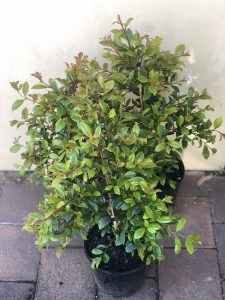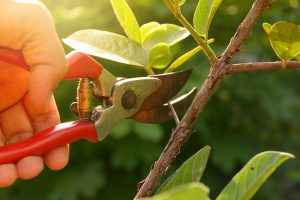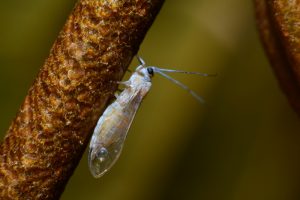We all like our privacy. We want to enjoy the privacy of our backyards. If you have neighbours who might be too friendly or like to pry, we recommend putting up a beautiful hedge. Hedging plants, like the Backyard Bliss, are perfect to help protect your privacy while enhancing the beauty of your backyard. So if you have some prying neighbours, we will discuss why you need the stunning Backyard Bliss in your life!
What is the Backyard Bliss?
The relatively new Backyard Bliss is a new species of Lilly Pilly, a native Australian plant. It is a form of Syzygium panicutala, that is also resistant to psyllids. It is incredibly fast-growing, reaching around 3-4 metres tall, depending on the soil conditions. It is easily pruned with foliage that ranges from orange to bronze, turning a deeper green with age. The flowers are creamy white in summer. It looks stunning all year round and is a great option for a hedge or dense screen around your home or pool. It is also perfect as a container specimen for the topiary. Because it can grow quickly, it is perfect for quickly growing a hedging screen to create privacy from neighbours.
It stands out best as a hedge or dense screen around a pool or courtyard, giving a dense but gentle look to your backyard.
This is an excellent plant as an Australian native, and will grow well from the temperature weather in Melbourne and Sydney to more subtropical weather around Brisbane and Cairns. Backyard Bliss is both frost-tolerant and drought-tolerant once established.
Planting Backyard Bliss
The Backyard Bliss loves full sun to partial shade. It will not grow at its best in deep shade. While you can plant all year round, the best time to plant is in late summer to autumn. This is because the soil will still be warm, which will encourage good root development. As a result, you will not need to water as frequently. Backyard Bliss grows best in humus rich, well drained soil. New plants should be watered well through the first summer until the root system is well developed.
After a year or two, your Backyard Bliss plants require little water except in dry years—Fertilise with a fertiliser specific for native plants in spring.
How Far Apart Should I Plant Backyard Bliss?
With a spread of around 1-2 metres, it is natural to be confused about how far apart to plant your trees. Plant bare rooted plants between 40-65 cm apart, in a double staggered row. Plant at 40cm apart, or 5 plants per metre for a thicker hedge that grows faster.
Pot grown plants, however, are slightly different. The size, habit, and pot size are the main factors when govern the appropriate spacing for the hedge. Use your own judgement based on the size of the plant, plant spread, and pots.
If you are planning a low hedge-like decoration for a garden or driveway, then we suggest you use smaller pots – no bigger than 20cm – with plants at 5 to a metre. This will allow the Backyard Bliss to grow thick and allow you to clip them to the height you desire, creating a more solid looking structure.
When planting near an existing fence or wall, make sure you leave at least 45-60cm of space between the trees and the wall. The wider the better if you are going to grow a taller screen of Backyard Bliss.
Pruning Backyard Bliss
Pruning Backyard Bliss is very easy. It is best carried out regularly to maintain a good, bushy growth. You can hard prune, if you feel it is needed, and the plant will recover well in most circumstances. It is best to prune in winter, just before new growth begins.
When pruning Backyard Bliss use sharp secateurs, shears, or electric trimmers. Trim the new growth back to around a few centimetres of its origin. To do this, find the line of the previous trimming (this is indicated by a line of darker foliage) and use that as your guide. Use a string line as a guide when pruning hedges and stand back ate regular intervals to review your progress – it’s always better to cut off too little than too much.
Follow the branch from base to tip, to make sure it won’t leave a hole when removed. Gaps can be covered by regularly pinching, tip pruning, or by training new growth across the hole.
Hedges need ongoing pruning to maintain their shape. Always prune then the new growth reached about 7.5cm. some hedges need 1-2 trims a years, while others need pruning once a month to every six weeks in warmer months. Always remove spent flower heads, as well, when trimming.
Screen or Hedge?
It can be hard to decide what you need – a screen or a hedge. And what is the difference between a screen or a hedge? Hedges tend to be a more solid structure, ideal for tightly foliaged trees with smaller leaves, that can be clipped easily to shape. Hedged tend to be smaller though, if you take the time, the incredibly grandeur of a tall hedge is well worth all the trouble and care.
A screen tends to be a lot softer and more often used for privacy or protection, over decoration, due to their characteristics. They tend to be taller because they can be more difficult to clip as they grow tall, faster.
Is Backyard Bliss Poisonous to Dogs?
As Australians, we love our dogs. And we want to protect our fur babies at all costs. Which means we’re not keen on bringing potentially poisonous plants into our backyards where our pups play. And as a lilly pilly breed, there is the concern of fruiting with the Backyard Bliss. Thankfully, lilly pilly species are perfectly safe for dogs. The worst that can happen, if they eat too many of the shed berries, is some gastrointestinal upset (if concerned, please take your dog to a vet) but otherwise, Backyard Bliss is considered non-toxic to dogs. The plant may produce an irritant oil that will make them unpleasant for the dogs to nibble on, but many vet practices utilise Backyard Bliss and other lilly pilly species, so they are definitely a great option for your home.
Are Backyard Bliss Roots Invasive?
There’s nothing worse than planting and new tree or plant and find the roots twisted and entwined within your plumbing – or your neighbour’s plumbing! This can turn into an extremely costly headache. Thankfully, Backyard Bliss, like most lilly pilly species, has non-invasive roots, meaning your pipes are safe.
Backyard Bliss and Psyllids
Psyllids are nasty little insects that love to pray on the type of tight, foliage plants commonly used for hedges and screening. They get right into the stems and sap, destroying the beautiful leaf system and your hedges in the process. Some lilly pilly varieties are susceptible to psyllids and it is always important to check plants for signs of damage before buying them.
Backyard Bliss, thankfully, is psyllid resistant and makes a fantastic addition to your backyard.
Are you looking to create a little more privacy to your backyard? Aumann’s Garden Supplies has a wide range of hedging plants, including Backyard Bliss, available. Come in store today and have a chat with our friendly staff for more information!

